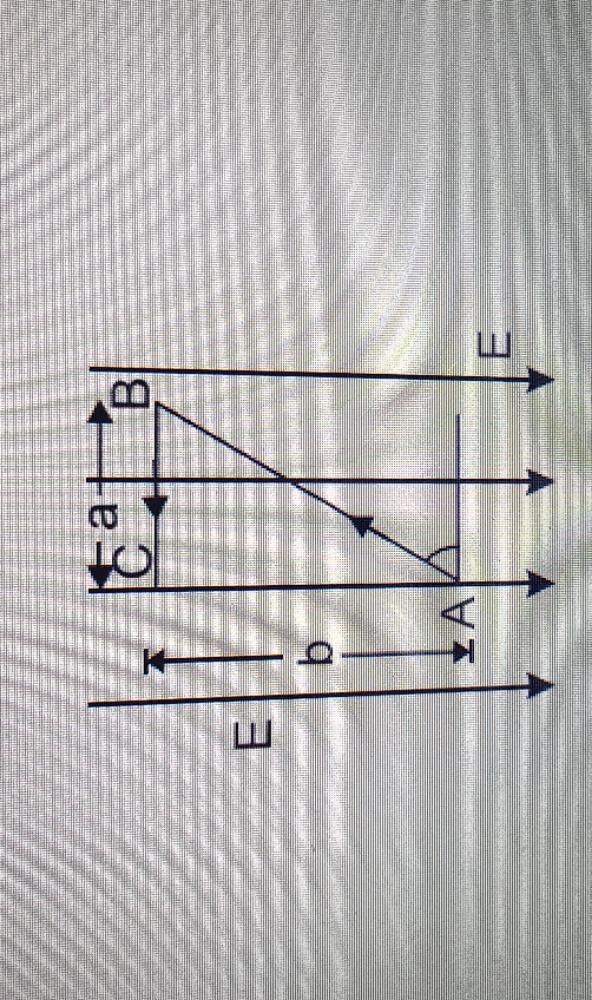JEE Exam > JEE Questions > The potential difference between points A and...
Start Learning for Free
The potential difference between points A and B in the given uniform electric field is :?
Most Upvoted Answer
The potential difference between points A and B in the given uniform e...
Uniform Electric Field and Potential Difference
Uniform Electric Field
A uniform electric field is a type of electric field wherein the direction and magnitude of the electric field is constant throughout the space. It is a special case of an electric field wherein the lines of force are straight and parallel to each other.
Potential Difference
Potential difference is the difference in electric potential between two points. It is also known as voltage and is measured in volts (V). The potential difference between two points represents the amount of work done per unit charge in moving a charge from one point to another against the electric field.
Calculation of Potential Difference
The potential difference between points A and B in a uniform electric field can be calculated using the formula:
V = Ed
Where V is the potential difference, E is the electric field strength, and d is the distance between points A and B.
Explanation
In a uniform electric field, the electric field strength is constant, and the lines of force are straight and parallel. Therefore, the potential difference between two points A and B in the field is directly proportional to the distance between them. The greater the distance, the greater the potential difference.
For example, if the electric field strength of the uniform electric field is 100 N/C, and the distance between points A and B is 2 meters, then the potential difference between points A and B is:
V = Ed = 100 N/C x 2 m = 200 V
Conclusion
The potential difference between points A and B in a uniform electric field depends on the electric field strength and the distance between the points. The greater the electric field strength and the distance between the points, the greater the potential difference.
Community Answer
The potential difference between points A and B in the given uniform e...


|
Explore Courses for JEE exam
|

|
Question Description
The potential difference between points A and B in the given uniform electric field is :? for JEE 2025 is part of JEE preparation. The Question and answers have been prepared according to the JEE exam syllabus. Information about The potential difference between points A and B in the given uniform electric field is :? covers all topics & solutions for JEE 2025 Exam. Find important definitions, questions, meanings, examples, exercises and tests below for The potential difference between points A and B in the given uniform electric field is :?.
The potential difference between points A and B in the given uniform electric field is :? for JEE 2025 is part of JEE preparation. The Question and answers have been prepared according to the JEE exam syllabus. Information about The potential difference between points A and B in the given uniform electric field is :? covers all topics & solutions for JEE 2025 Exam. Find important definitions, questions, meanings, examples, exercises and tests below for The potential difference between points A and B in the given uniform electric field is :?.
Solutions for The potential difference between points A and B in the given uniform electric field is :? in English & in Hindi are available as part of our courses for JEE.
Download more important topics, notes, lectures and mock test series for JEE Exam by signing up for free.
Here you can find the meaning of The potential difference between points A and B in the given uniform electric field is :? defined & explained in the simplest way possible. Besides giving the explanation of
The potential difference between points A and B in the given uniform electric field is :?, a detailed solution for The potential difference between points A and B in the given uniform electric field is :? has been provided alongside types of The potential difference between points A and B in the given uniform electric field is :? theory, EduRev gives you an
ample number of questions to practice The potential difference between points A and B in the given uniform electric field is :? tests, examples and also practice JEE tests.

|
Explore Courses for JEE exam
|

|
Signup for Free!
Signup to see your scores go up within 7 days! Learn & Practice with 1000+ FREE Notes, Videos & Tests.


















